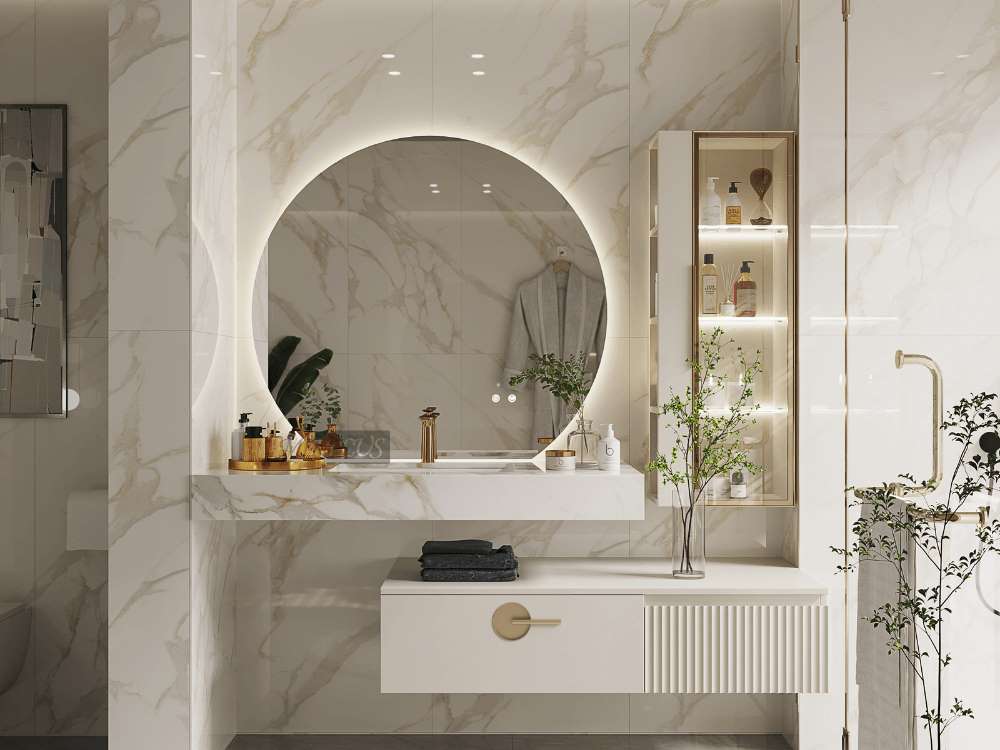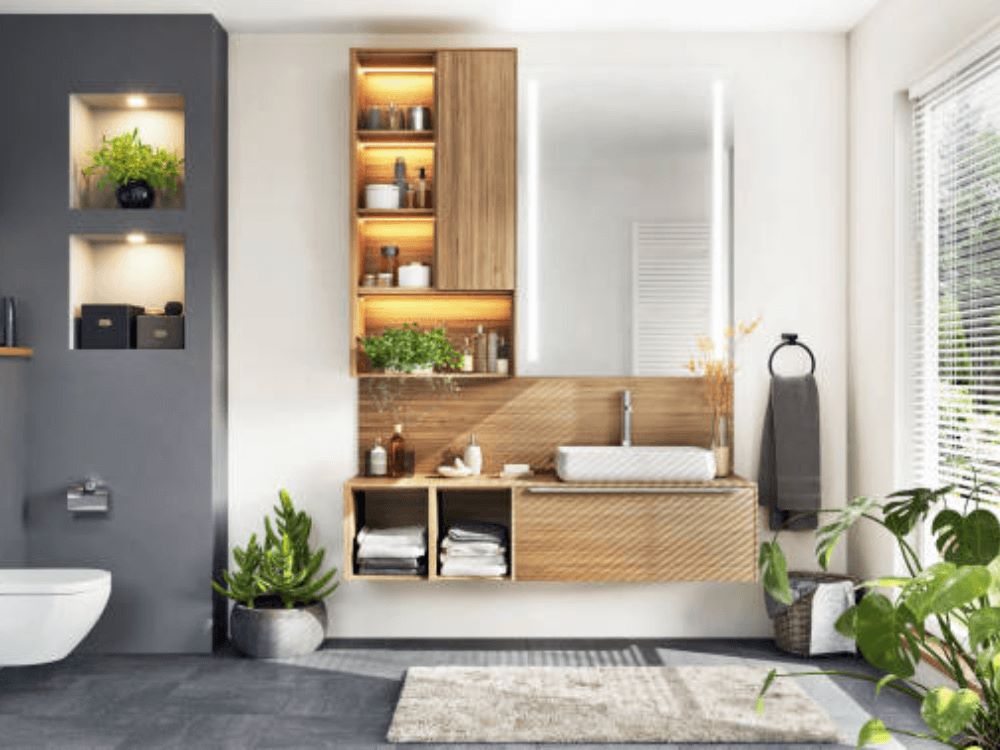Updating your bathroom vanity is one of the easiest ways to give your space an instant refresh.
But before you dive in, one question always comes first: What bathroom vanity size do I need? Choosing the right bathroom vanity size isn't just about aesthetics; it’s about ensuring functionality and comfort in your daily routine. With various dimensions, styles, and features to take into account, making an informed decision can feel overwhelming. Let’s break down the most common bathroom vanity sizes, how to measure correctly, and what factors matter most when planning your bathroom update.
A bathroom vanity is more than just a sink and cabinet. This definition gives people considerable flexibility in choosing their vanity options. From standard sink-and-mirror combinations to vanities with built-in lighting and storage, you'll find every style you need within the bathroom vanity collection.
With a wide variety of vanity styles available, you have more options to choose from in terms of materials, colors, cabinet handles, and basins.
Related Article: You Best Guides to Choosing New Bathroom Cabinet
Due to the wide variety of bathroom cabinet styles, there are no fixed standard dimensions for bathroom cabinets. However, as the market has evolved, a number of popular bathroom vanity sizes for vanities have gradually emerged. Some common vanity sizes include:
Of course, when considering the dimensions of bathroom vanities and sinks, it's essential to account for the needs of all users. For instance, if there are individuals with physical limitations in the household, you might prefer a shorter height to ensure everyone can comfortably reach the sink fixtures.



While planning your dream bathroom, understanding bathroom vanities can feature more than one sink. A double-sink vanity is particularly well-suited for multi-person households, allowing for more efficient time management.

Double bathroom vanity sizes typically range from 60 to 84 inches in width, creating ample space for two sinks and generous countertop area. For the best results, you’ll want a standard height of 32 to 36 inches, which guarantees comfortable access for everyone.
Depth usually hovers around 21 inches, providing enough room for your essentials without overwhelming the space.
Related Article: Single vs Double Sink Vanities: How to Choose the Best for Your Bathroom
Double vanities offer spacious elegance, but single vanities play an essential role in smaller bathrooms or guest spaces, maximizing functionality without compromising style. With single sink, it can maximize available space and provide essential storage space and functionality.
When choosing a single vanity, standard bathroom cabinet sizes typically range from 24 to 48 inches wide. A 30-inch vanity (75 cm) is often perfect for compact areas, providing ample storage while maintaining a streamlined look.

When you're choosing your vanity, think about how this depth allows for comfortable use without overwhelming the bathroom. Too shallow, and you’ll run out of countertop area. Too deep, and the vanity might dominate the room.
The perfect depth for a bathroom vanity typically falls between 450mm and 500mm, striking a balance between functionality and space efficiency.
Related Article: Vanity Cabinet Depth: A Comprehensive Guide for Cabinet Buyers
Since there isn't a standard bathroom vanity size, make sure to measure both your space and the vanity.
Typically, a standard height of around 850mm suits most users. If you’re on the taller side, consider a comfort-height vanity between 900mm and 1000mm. This reduces bending and makes your tasks more seamless.
Related Article: Choosing The Perfect Standard Height of Medicine Cabinet Wholesale
Choosing the right bathroom cabinet size starts with measuring your space accurately, so don’t skip this essential step. A well-planned cabinet not only enhances storage but also elevates the overall style of your bathroom. Here's a step by step guide to help you choose the right bathroom cabinet sizes.
Measuring the width of your bathroom is essential for selecting the perfect bathroom vanity size. Start by using a tape measure to determine the distance between walls, guaranteeing you account for any obstacles like doors or windows.
Once you’ve determined the width of your bathroom, the next step is to assess its depth. Measuring the depth is essential for selecting a vanity that complements your space without overwhelming it.
Aim for a depth of 450mm to 500mm, making sure it fits comfortably in your layout.
Standard heights typically range from 30 to 36 inches, but it’s important to take into account your specific needs. If you’re taller, a comfort-height vanity around 34 to 36 inches can alleviate strain while you use it daily. If multiple people share the space, aim for 32–36 inches (80–90 cm) as a universal height.
Prioritize measurements and clearances to guarantee smooth movement and accessibility, while a well-placed vanity not only enhances aesthetics but also elevates usability.
Related Article: How to Install a New Bathroom Vanity and Sink
When choosing your bathroom vanity, the style you prefer can greatly shape its size.
As you explore various vanity styles, you'll quickly notice that each design not only enhances the bathroom's aesthetic but also greatly influences its size and functionality.
Choosing the right style is essential, as it determines how much space you’ll have for storage and movement.

Except for the bathroom vanity itself, the distance from other bathroom features—like the toilet, shower, and doorways—plays a pivotal role determining your vanity's dimensions.
To guarantee a smooth flow, maintain at least 30 inches of open space in front of the vanity and 15 inches between it and adjacent fixtures. This thoughtful spacing creates an inviting environment, allowing you to access essentials comfortably.
A bathroom cabinet truly shines when it harmonizes with its surroundings. Therefore, precise planning before selection ensures the sink complements the overall layout, achieving a perfect blend of style and functionality.
In your quest for the perfect bathroom vanity, remember that 30% of homeowners regret their bathroom vanity size choice after installation. By carefully considering dimensions and your space's unique needs, you can avoid that regret and create a stylish, functional oasis. With careful measuring, smart planning, and the right layout, you’ll avoid that mistake — and create a bathroom that feels tailor-made for you.
Whether you prefer a sleek wall-mounted design or a spacious double vanity, the perfect fit will make your bathroom more beautiful and functional.
Q1. What materials are commonly used for bathroom vanities?
Wood, laminate, quartz, and granite are all popular. Each offers unique looks and levels of durability — choose based on your budget, humidity, and style preference.
Q2. How can I personalize my bathroom vanity’s style?
Mix and match finishes, handles, and countertops. Add accessories like trays, plants, or mirrors with LED lighting to give your vanity area a personal touch.
Q3. Are there eco-friendly bathroom vanity options?
Yes! Look for sustainable materials like bamboo, reclaimed wood, or eco-certified composites. They’re stylish, durable, and environmentally conscious.
Q4. What are the best finishes for durability and easy cleaning?
High-gloss laminate and solid surfaces resist stains and scratches, while matte finishes hide fingerprints but may require more regular care.
Q5. How do I choose the right sink type for my vanity?
Consider both your style and space. Vessel sinks make a statement, undermount sinks look sleek and easy to clean, and integrated basins offer a minimalist, seamless look.
Uncover a realm of opportunities.

Hi, I’m Emmy, a bathroom design enthusiast. My company Mirplus, backed by a team of professional designers, is dedicated to helping people select the perfect bathroom cabinets. I hope my articles can be helpful to you when choosing bathroom products in the future.
Copyright 2022 - All Mirplusbath